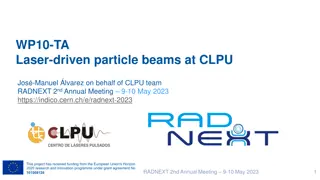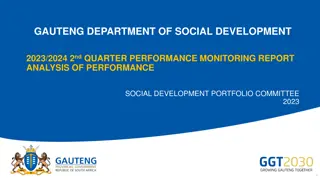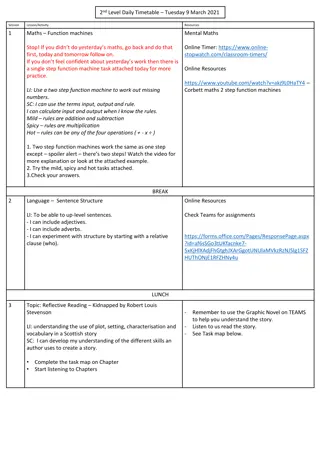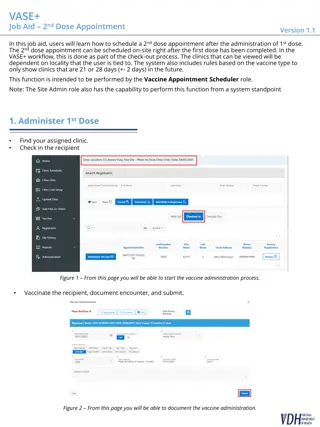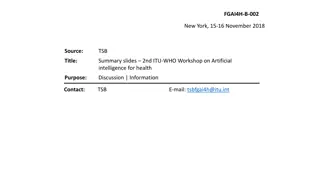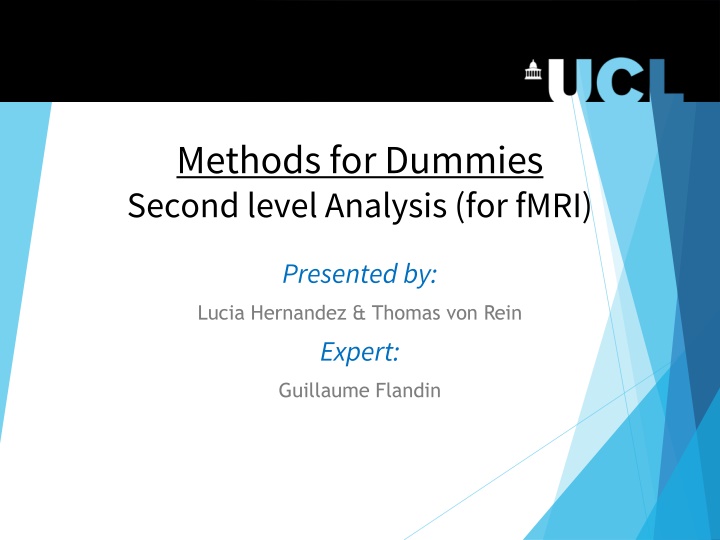
Advanced fMRI Analysis Techniques: Second Level Insights
Explore second-level fMRI analysis techniques through an expert-led presentation covering fixed vs. random effects, statistical parametric maps, design matrices, contrast images, spatial preprocessing, and more. Enhance your understanding of group-level analysis and voxel activation differences across subjects.
Download Presentation

Please find below an Image/Link to download the presentation.
The content on the website is provided AS IS for your information and personal use only. It may not be sold, licensed, or shared on other websites without obtaining consent from the author. If you encounter any issues during the download, it is possible that the publisher has removed the file from their server.
You are allowed to download the files provided on this website for personal or commercial use, subject to the condition that they are used lawfully. All files are the property of their respective owners.
The content on the website is provided AS IS for your information and personal use only. It may not be sold, licensed, or shared on other websites without obtaining consent from the author.
E N D
Presentation Transcript
Methods for Dummies Second level Analysis (for fMRI) Presented by: Lucia Hernandez & Thomas von Rein Expert: Guillaume Flandin
Overview of todays talk 1. Recap of first level analysis 2. What is second level analysis? 3. Fixed vs. random effects 4. How do we analyse random effects? 5. Practical demonstration 6. Questions 2
1stLevel Analysis is within subject Y =Xx + fMRI scans Voxel time course Time Time (e.g. TR = 3s) 4
SPM{t} fMRI data Design Matrix Contrast Images Subject 1 Subject 2 Subject N 5
1st Level Analysis Spatial preprocessing Movement in scanner Fitting to standard space (MNI) Smoothing etc for statistical power 6
Overview of todays talk Recap of first level analysis Second level analysis Fixed vs. random effects How do we analyse random effects? Multiple conditions Practical demonstration Questions 1. 2. 3. 4. 5. 6. 7. 7
Statistical parametric map (SPM) Design matrix Kernel Realignment Smoothing General linear model Gaussian field theory Statistical inference Normalisation p <0.05 Template Parameter estimates 8
2nd level analysis across subjects It isn t enough to look just at individuals. So, we need to look at which voxels are showing a significant activation difference between levels of X consistently within a group. Average contrast effect across sample 1. Variation of this contrast effect 2. T-tests 3. 9
Overview of todays talk Recap of first level analysis What is second level analysis? Fixed vs. random effects How do we analyse random effects? Practical demonstration Questions 1. 2. 3. 4. 5. 6. 10
Fixed effects analysis Each subject repeats trials many times. The variation in responses for each level of the design matrix (X) for a given subject gives within-subject variance, w2. Take the group effect size as the mean of responses across our subjects and analyse it with respect to w2. 11
When to use FFX Only making conclusions about subjects - not for population E.g. case studies 12
When not to use FFX Want to make inferences about the population. FFX does not account for variation between subjects Need to model the random effect of subject selection 13
Random effects analysis (RFX) Synonymous with mixed effects models . Sample is a set of individuals taken at random from the population. To do this we need to consider the between subject variance, b2, as well as w2 and estimate the likely variance of the population from which our sample is derived. 14
Interim summary: Fixed vs Random 15 (from Poldrack, Mumford and Nichol s Handbook of fMRI analyses )
Overview of todays talk Recap of first level analysis What is second level analysis? Fixed vs. random effects How do we analyse random effects? Practical demonstration Questions 1. 2. 3. 4. 5. 6. 16
Random effects analysis (RFX) - Methods Hierarchical Summary statistics approach 17
Methods for Random Effects Hierarchical Most accurate method gold standard Set up a GLM containing parameters for the effects and variances at both the subject AND group levels, to all be estimated at the same time. Estimates subject and group statistics via iterative looping Computationally demanding 18
Methods for random effects Summary statistics 1st level design for all subjects must be the SAME Uses the same sample means as in the first level analysis Gives exact same results as hierarchical model (when the within-subject variance is the same for all subjects) Validity is undermined by presence of extreme outliers. 19
First level Second level fMRI data Design Matrix Contrast Images One-sample t-test @ second level Subject 1 T c t = ) T ( r a V c Subject N 20 Generalisability, Random Effects & Population Inference. Holmes & Friston, NeuroImage,1998.
Robustness Summary statistics Hierarchical Model 21 Mixed-effects and fMRI studies. Friston et al., NeuroImage, 2005.
Summary For fMRI data, usually preferable to use RFX analysis, not FFX Hierarchical models provide gold standard for RFX , BUT computationally intensive Summary statistics = robust method for RFX group analysis 22
Overview of todays talk Recap of first level analysis 1. What is second level analysis? 2. Fixed vs. random effects 3. How do we analyse random effects? 4. Practical demonstration 5. Questions 6. 23
Linear contrasts Contrast vector multiplied by parameter estimates: c = [1 0] = [ 1 2] COPE = 1 * 1 + 0 * 2 Group analyses Contrast of interest from each subject ( 1 from each participant) -2nd level t-test
Example 21 subjects Design: 2 x 2 factorial Emotion Emotional Neutral Offender Offender emotional Offender neutral Perspective Victim Victim emotional Victim neutral
Example: one-sample t-test Most basic test: Statistically appropriate way of simply averaging the images . Scans: Select the corresponding contrast file from each subject s first level folder. In this case con_0001.nii Results: For a one-sample t-test the only relevant contrast is 1 (or -1).
Example: covariates Add Affective empathy rating
Example: two-sample t-test Two-sample t-test: Compare two independently acquired data sets E.g. Emotion comparing victims vs. offenders Group
Alternative tests Paired t-test: Compare two dependent data sets E.g. multiple conditions of a task within a single subject One-way ANOVA: Statistical comparison of more than 2 groups E.g. Victims vs offenders vs healthy controls
Resources Previous MfD slides Slides from Guillaume Flandin s talk in Zurich, Feb 2014 Mumford, J. A., & Poldrack, R. A. (2007). Modeling group fMRI data. Social cognitive and affective neuroscience, 2(3), 251-257. Friston, K. J., Stephan, K. E., Lund, T. E., Morcom, A., & Kiebel, S. (2005). Mixed-effects and fMRI studies. Neuroimage, 24(1), 244-252. Poldrock, R. A., Mumford, J. A., & Nichols, T. E. (2011). Handbook of functional MRI data analysis. Cambridge University Press. https://doi.org/10.1017/CBO9780511895029


